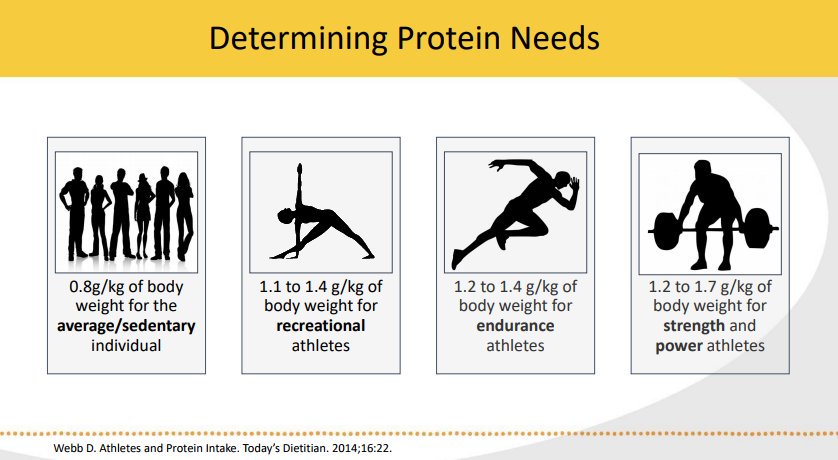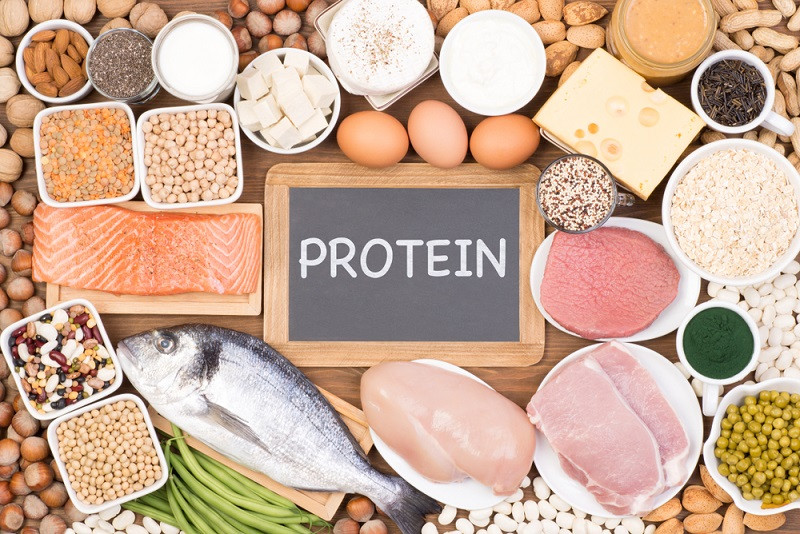How to Calculate Your Protein Needs
It’s important that we eat enough protein each day to cover our body’s needs. Protein helps your body to maintain a proper fluid balance, builds and repairs tissues, transports nutrients, and provides other essential functions.

Do you know how much protein you need? Everyone needs a different amount and there are many different factors that impact your number.
Determining Protein Needs

When determining your protein needs, you can either identify a percentage of total daily calories or you can target a specific number of grams of protein to consume per day. You also can use your weight and activity level as well as your lean body mass. Here is a closer look at each method.
Percent of Daily Calories
Current USDA dietary guidelines suggest that adult men and women consume between 10 and 35% of their total calories from protein. To get your number and track your intake, you’ll need to know how many calories you consume each day.
To maintain a healthy weight, you should consume roughly the same number of calories that you burn each day.
Once you know how many calories you consume, simply multiply that number by 10% and 35% to get your range. As an example, a man who consumes 2,000 calories per day would need to consume 200 to 700 calories each day from protein.
Protein Grams Per Day
As an alternative to the percentage approach, you can target a specific number of protein grams per day. One simple way to get a range of protein grams per day is to translate the percent range into a specific protein gram range. The math is easy.
Each gram of protein contains four calories. Simply divide the two calorie range numbers by four. A man who eats 2,000 calories per day should consume 200 to 700 calories from protein or 50 to 175 grams of protein.
There are other ways to get a more specific number which may take into account lean muscle mass and/or physical activity level.
You can determine basic protein needs as a percentage of your total daily calorie intake or as a range of protein grams per day.
Based on Weight and Activity
The average adult needs a minimum of 0.8 grams of protein per kilogram of body weight per day. One kilogram equals 2.2 pounds, so a person who weighs 165 pounds or 75 kg would need about 60 grams of protein per day.
However, your protein needs may increase if you are very active. The Academy of Nutrition and Dietetics, American College of Sports Medicine and the Dietitians of Canada suggest that athletes need more protein.
They suggest that endurance athletes (those who participate in activities like running, cycling, or swimming on a regular basis) consume 1.2 to 1.4 grams of protein per kilogram of body weight per day which translates to 0.5 to 0.6 grams of protein per pound of body weight.
The organizations suggest that strength-trained athletes (who participate in activities like powerlifting or weight training on a regular basis) consume 1.6 to 1.7 grams of protein per kilogram of body weight. This translates to 0.7 to 0.8 grams of protein per pound of body weight.
Based on Lean Body Mass
An additional method of figuring out how much protein you need takes into account activity level and lean body mass. Some experts feel that this is a more accurate technique since our lean body mass requires more protein for maintenance than fatty tissue.
Lean body mass (LBM) is simply the amount of body weight that is not fat. It includes bone, water, muscle, organs, and other tissues. There are different ways to determine your lean body mass, but the easiest is to subtract your body fat from your total body mass.
First, you’ll need to determine your body fat percent. There are different ways to get the number including body fat testing with skin calipers, BIA scales, or DeXA scans. You can also estimate body fat with this calculator.
Next, calculate your total body fat in pounds. Multiply your body weight by the body fat percentage. For example, if you weigh 150 pounds and your fat percentage is 30 then 45 of those pounds would be fat (150 x 30% = 45).
Lastly, calculate lean body mass.Simply subtract your body fat weight from your total body weight. Using the same example, the lean body mass would be 105 (150 – 45 = 105).
Calculate Daily Protein Need
To determine your daily protein need, multiply you LBM by the appropriate activity level.
- Sedentary (generally physically inactive): multiply by 0.5
- Light activity (includes walking or gardening): multiply by 0.6
- Moderate (30 minutes of moderate activity, thrice weekly): multiply by 0.7
- Active (one hour of exercise, five times weekly): multiply by 0.8
- Very active (10 to 20 hours of exercise weekly): multiply by 0.9
- Athlete (over 20 hours of exercise weekly): multiply by 1.0
Based on this method, a 150-pound person with an LBM of 105 would require a daily protein ranging between 53 grams (if sedentary) to 120 grams if athletic.
Health Benefits
Protein helps to maintain body tissues, including muscles, organs, nervous system, blood, skin, and hair. It also serves as a transport mechanism for oxygen, fats, vitamins, and minerals.
In addition, eating protein can help you manage your weight because it takes longer to digest a protein-rich meal. After consuming a meal with protein, you’re likely to feel full and satisfied longer.
Some protein foods have additional health benefits. Fish, such as salmon, tuna, herring, and trout, are high in protein and also omega-3 fatty acids that are essential for health. Legumes are high in protein and they’re high in fiber and contain phytochemicals that may have health benefits.
Deficiency
Unlike fat and glucose, our body has little capacity to store protein. If you were to stop eating protein, your body would start to break down muscle. Protein deficiency is rare in developed countries. However, it can happen if you’re not eating enough food every day.
Overconsumption
On the flip side, it is possible to eat too much protein. Some people believe that excess protein is excreted in the urine. However, only part of the protein is excreted. Another part of the protein is converted to glucose for energy or stored as fat.
So if you eat too much protein—and too many calories as a result—you run the risk of gaining weight from excess calories. If your calorie goal stays on track but you get more protein than you need, you are probably not getting enough carbohydrates or fat for your body to function properly.
The key to proper nutrition is achieving the proper balance of macronutrients. Eating large amounts of protein can lead to dehydration, even in elite athletes. So if you follow a high protein diet, it’s important to drink extra water.
Protein Sources
Protein comes from both plant and animal sources and you can meet your protein needs with either type of protein. A good protein source is one that’s prepared in a way that doesn’t add extra fat, sugar, or extra sodium.
Meat and Seafood
Lean meats, poultry, fish, seafood, eggs, and dairy products are all excellent sources of protein. These foods can be grilled or roasted to minimize added fat.
You can also choose lower-fat cuts of meat or remove the skin from chicken or turkey to cut fat and calories. Coldwater fish such as salmon, tuna, and herring make good protein choices because they’re also rich in omega-3 fatty acids.
Plant-Based Protein
Legumes, nuts, and seeds are good sources of protein. Some vegetables (such as spinach or kale) and grains (such as quinoa) also provide protein in small amounts.
Keep your plant proteins healthy by choosing recipes and cooking methods that preserve their nutritional benefits. For example, use tofu in place of meat in a stir-fry, add nuts or seeds to a dinner salad, or use dry beans like kidney, navy or black beans as your primary protein source for a few meals.
Getting More Protein
Here are a few tips to get more protein in your healthy diet.
- Serve scrambled eggs and spinach for breakfast.
- Choose turkey bacon or sausages that are lower in fat. Better yet, look for brands with reduced sodium.
- Add seeds or chopped nuts on top of a veggie side dish.
- Snack on a handful of almonds instead of starchy foods.
- Buy lean cuts of meat and serve them with lots of dark green and colorful veggies.
- Eat more fish, but avoid breaded fish. Choose baked or poached fish instead.
- Serve baked or roasted chicken instead of fried chicken.
- Make a stir-fry with pieces of chicken and fresh veggies.
Keep in mind that one serving of protein usually comprises 3 to 5 ounces of meat, poultry or fish, one egg, 1.5 ounces of cheese or about 12 walnuts.
You can also use other methods to consume the right portion size. A serving of meat, poultry, or fish is about the size of the palm of your hand. A serving of cheese is the same size as two dice.
Guidelines for Special Populations
Many sources that provide protein guidelines provide numbers for adult men and women. But there are certain populations that may need more or less to manage a medical condition or facilitate growth.
While a doctor or dietitian would be best suited to determine your ideal percentage, there are some general guidelines that can help:
- Children and teenagers need more protein (up to 25% of total calories) than adults.
- Pregnant and lactating women need more protein than women who are not pregnant.
- Older adults need more protein than middle-aged adults.
- People with liver or kidney disease need to decrease protein intake (up to 10% of total calories or less).







